WWW.HAUSSITE.NET
Passwor(l)ds
23 / 02 / - 29 / 04 / 01
Exhibition / Screening / Talk
Passworlds
Anri Sala (ALB)
Hollis Frampton (USA)
Jonas Mekas (LT / USA)
Passwor(l)ds
introduces into
the exhibition space three artist's methodologies which analyze issues of
autobiography, recollection and the restructuring of the relation between
image and voice.
As the title suggests, the concept emphasizes the notion of identity as being
shaped by a specific experience inside of a cultural framework, which in order
to be accessed requires a specific method, the use of a password, a voice.
Thereby the concept
alludes to the structure of identity as something that is neither self evident,
nor a static and given condition. A password is needed in order to gain access
to a world formatted by media, that on the one hand is based on purely visual
materials, and on the other on a voice that recounts, describes, and eventually
falls silent.
The project considers these works through the media as artifact, not as fact,
and allows for views of the mechanics of media set in relation to the structuring
of memory, reminiscence and awareness precisely in regards of the role of
the spoken word. The visual footage privileges an individual’s biographical
insight contained within the spoken narrative. Thus, within the range of an
always very specific time, identity is described as a system which is composed
by the agency of media artifacts.
Anri Sala is represented through his film Intervista from 1998, as well as Silent Duel, a new project that entails the idea of a 'video kiosk' produced as a correspondence to the haus.0 philosophy of the media plug-ins. In Silent Duel Sala draws from memories of films as if those were his own, which in fact, they have become. His approach towards the idea of autobiography is based on the organizing principle of a media format as a collection of film footage.
So the access to memory is defined by the specific media, as well as the visual cores of the media become memories, an exchange process that in Frampton's work is, being articulated by voices accompanying the passages as photographs burn up as if to release their narrative on a film. In this process also the relation of voice and image is at stake since what is described never matches that what is seen in the frame of the photo. The voice thus not only comments but structures the image.
In Reminiscences of a Journey to Lithuania Mekas tells about the impossibility of really returning to a place from which one has been exiled, and his attempt of reconstructing a past that he only remembers. He collects together pieces of a world that has been almost accidentally framed by his camera, in an attempt of speaking of the past while at the same time reinventing it. Small film diary entries, shifting contexts and timelines, past and present are contained in the frame of an image. One moves from an individual perspective that turns out to be constructed as well to a system that uses footage of films like foot notes, like passwords conjuring up new tales. If it was possible to collect and record one's dreams, maybe the collection of Sala's video kiosk would be close to an anticipation of such an endeavour, that found its very origins precisely in the mundane format of consumer vhs.
Anri Sala
(*1974)
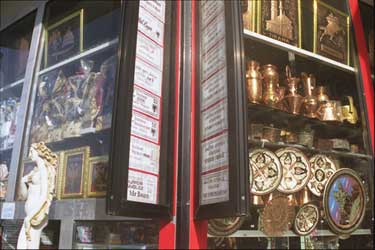
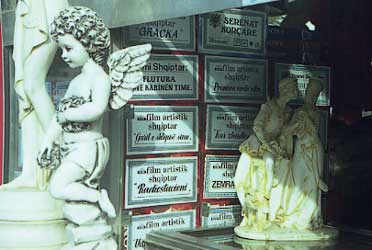
Kiosk Tirana, images Anri Sala.
Silent Duel
(2001)
SILENT DUEL I LOVE YOUR NAME WARM HAND ALLEYS THAT LONG FOR SUN SNOWED UP
PATHS GENERAL GRAMMAPHON MAN WITH GUN THE LADY FROM TOWN THE COMRADE FROM
TOWN THE EIGHTH IN BRONZE OPERATION FIRE RETURN OF THE DEAD ARMY LIEUTENANT
WOODS OF FREEDOM CONFRONTATION CUT THREADS
"The idea to bring these different videos together was a lucky incident, which I liked because I felt that I had not made a selection which criticised or supported the worth of the different films, but one which is more about a remembering and memory, rather than logical and rational, and which was developed in a small souvenir shop in Tirana. All of these are films I had watched during my childhood. I have also seen other films, but I did not find them here in this souvenir shop.
I couldn’t remember most of the titles or which action was part of which film. What I do have is a lot of anecdotes from different films. These come from dialogs which were part of my memories or which I remembered when now watching the films again. Certain phrases which are part of the dialog have formed by now phrases of our everyday language, filmicwords which left the screening hall together with the audience, words which entered the streets and are used by people when they find themselves in situations similar to those watched in the film. This could be seen as a filmic recapturing of everyday-life, the restaging of the actions of other people.
Then there are also mysterious script details whose impression on me - if they left any at all - I can’t recall. I selected them today because they were surprisingly clear for their time or touched me with a certain naivité and subserviance. When watching these films again I like them because of the memories they conjure up along with the films’ weaknesses and their mission to educate the New People. The ideological rhetorical alchemy has been lost over the time and the phrases of the New People are attached to the films' structure like old rags, which look today like faded wallposters of products which no longer exist. Other films which have been shown along side Albanian films were Vietnamese, Indian and Turkish, as well as Charlie Chaplin’s beautiful silent and sound films. Maybe because he raised the Red Flag in "Modern Times".
I would hope that
this outline stays within the parameters of the unintentional wish, how to
say, to look like a situation which is like spending a boring weekend at home
alone with a heap of videos. I have named this small video kiosk "Silent
Duel", which is also the name of the first film on the list. It is about
four people meeting on a war ship, they are urrounded by the sea and quarrel
about the direction of their journey. They want to sail in two different directions,
three want to flee to the West, the fourth one struggles till the end to return
the ship to the base. When they realise that they have reached international
waters which do not belong to any wave or point on a map they all hug each
other and shout like mad: "Hurray, hurray, victory, we reached the free
world." One sees them surrounded by 360 degrees of water and sun, a "free
world" without a coast and references - references which are later added
by other films, which are still missing from this involuntary weekend collection."
Anri Sala, 2001
Intervista
(1998), 26 min, DVD
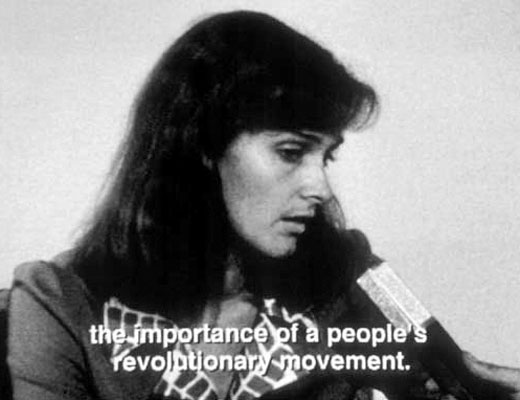
Intervista
In the process of moving house with his family, Anri Sala discovered a twenty-year-old 16mm newsreel film, containing images of a congress of the Albanian Communist Party. In the film a young woman, a leader of the Communist Youth Alliance, is seen making a speech, and later giving an interview. Since the sound of the film was lost, because it had been recorded separately, it was not possible to make out what she was saying. It was not any young woman, but the artist’s mother, Valdet. Intent on learning the contents of the speech and interview, which Valdet could not remember, Sala visited old party leaders in the hope that they might remember. But they were old then, and the specifics of the speech had eluded them. He visited the film studio, and met with the sound recordist of the newsreel, but could not find any of the original sound, or anyone who would remember what his mother actually had said. So the film was taken to a school for the deaf in Tirana, and with the help of lip readers, Anri Sala’s mother’s words were deciphered. "Intervista" dramatically captures the moment when Sala shows his mother a video of the film again. This time, with her words recovered and subtitled on the screen, she confronts her younger self. Her Communist ideals and the current chaos in Albania collide, offering a moving opportunity for reflection on the country’s (and one woman’s) history and present state.
Hollis Frampton
(US) (1936-1984)
Nostalgia (1971), 36 min, 16mm
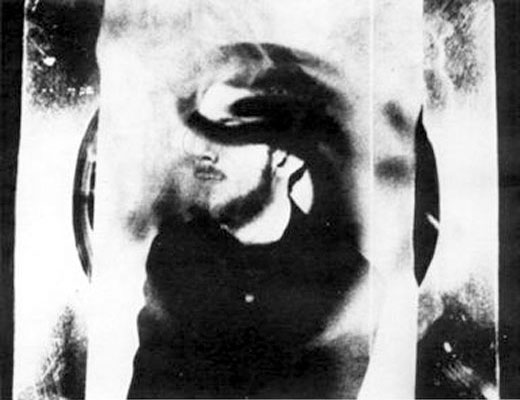
Nostalgia
"[Nostalgia]
is mostly about words and the kind of relationship words can have to images.
I began probably as a kind of non-poet, as a kid, and my first interest in
images probably had something to do with what clouds of words could rise out
of them...I think there is kind of a shift between what is now memory and
what was once conjecture and prophecy and so forth."
Hollis Frampton
Hollis Frampton’s 1971 black and white film Nostalgia is composed of twelve still photographs, each accompanied by a voice over commentary and reminiscence, though sound and image are out of synch. The camera shows us one image while the voice describes another, yet to come. Each photo is marked sonically by nostalgia and anticipation. The movie camera "shows" each photograph, and simultaneously registers its destruction. One by one the photos are placed on a gas ring and each shot lasts as long as it takes for the photograph to burn up. The movie camera registers this disappearance, this burning up of the still image, as movement, it animates the still image as it destroys it - the photographs curl and tremble and dance, shudder, waver, and crumble into ash. Nostalgia thus stages an encounter between photography and cinema, between stillness and movement, sound and image, present and past. In recording and destroying the still photographs cinematographically Frampton, in a sense, remakes them. He also documents a discovery: the final commentary describes how, at the moment of taking the photograph, the camera had captured something he had not seen. This aberrant chance detail, caught and revealed by the mechanical apparatus, is subjected to scrutiny via enlargement, so he tells us, to such an extent that it becomes virtually illegible.
"The art of narration of most of the young authors is an autobiographic one", remarked Frampton in 1972. "As I didn't know much about narrational films it seemed logical to me to accept the form of biography as something conventional." Frampton wanted to convey and "narrate" something as well, as he had to link it with his formalistic way of production he had to formalize his authorship as well, as for him the death of the author is the emergence of the productive audience. He reaches his goal even though he has to include within the productiveness of perception the re-invention of the author. He also plays with this subject in his films, like Nostalgia (1971), when he adopts a radical and subjective perspective and uses the biographic memory as sujet.
During the 1960s Frampton experimented with both photography and filmmaking. The tension between the two media frustrated and fascinated Frampton. He evolved from a still photographer to a leading figure in the avant-garde film movement known as "New American Cinema", which flourished in the 1960s and 1970s. Beginning in the fall of 1973 Frampton started teaching at the State University of New York . He had much to do with the development of the Center for Media Study which subsequently attracted other filmmakers such as Paul Sharits and Tony Conrad. It was an association that lasted until a month before he died in March, 1984.
Jonas Mekas
(US/LT) (*1922)
Reminiscences of a Journey To Lithuania (1971-72), 82min
"I have a
feeling I am neither in Europe nor in America. I feel like I am in no place,
on the brink of an empty space between misery and dreams".
Jonas Mekas, 1972
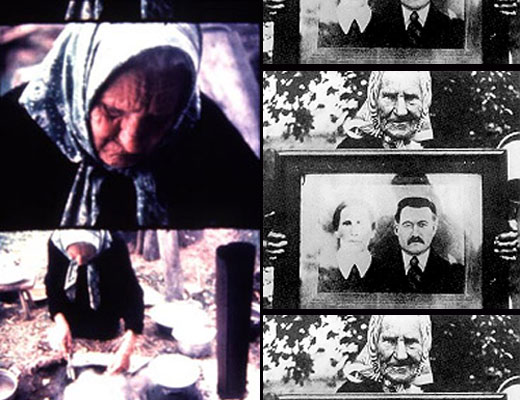
Reminiscences of a Journey to Lithuania
"The film consists of three parts. The first part is made of footage I shot with my first Bolex during my first year in America, mostly from 1950-1953. It shows me and my brother Adolfas, how we looked in those days: miscellaneous footage of immigrants in Brooklyn, picnicking, dancing, singing; the streets of Williamsburg.
The second part was shot in August 1971, in Lithuania. Almost all of the footage comes from Semeniskiai, the village I was born in. You see the old house, my mother, all the brothers, goofing, celebrating our homecoming; you see some of the places we used to know; you see some of the field work, and other insignificant details and memories. You don’t see how Lithuania is today; you see it only through the memories of a Displaced person back home for the first time in twenty-five years.
The third part
begins with a paranthesis in Elmshorn, a suburb of Hamburg, where we spent
a year in a forced labor camp during the war. After the parenthesis closes,
we are in Vienna where we see some of my best friends - Peter Kubelka, Hermann
Nitsch, Annette Michelson, Ken Jacobs. You also see the Monastery of Kremsmünster,
the castle of Nitsch, the house of Wittgenstein, etc. The film ends with the
burning of the Vienna fruit market, August 1971."
Jonas Mekas
Born in 1922 in
the Lithuanian village of Semeniskiai, Jonas Mekas would go on to become one
of the most important figures of the American independent cinema. Together
with his brother, he would be taken by Nazis in 1944 and sent to a forced
labor camp in the suburbs of Hamburg where he would spend eight months. When
the war ends, the Mekas brothers spend four years in a number of different
Displaced Persons Camps run by the Allies. In the late fall of 1949 the Mekas
brothers arrive in America and settle in Brooklyn. Two weeks after his arrival
in America, Mekas borrows the money to buy his first Bolex 16mm camera and
begins to record moments of the life. "I had only bits of time which
allowed me to shoot only bits of film" he explains "I said to myself
- Fine, very fine - if I don’t have time to devote 6 or 7 months to making
a film, I won’t break my heart about it; I’ll film short notes,
from day to day, every day .. if I can film one minute - I film one minute."
In 1971, for the first time since his departure 25 years earlier, Mekas returned
to Lithuania.
"The time in Lithuania remained suspended for me, for twenty-five years,
and now it’s beginning to move again" he discovered."
Parallel to his own film-making activity, Mekas had an extremely important and influential career as organizer, editor, writer, promoter and "warrior" for the cause of independent and experimental cinema.